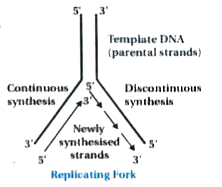Describe various enzymes involved for DNA Replication.
The process of replication required a set of catalysts (enzymes) as given below:
DNA Dependent DNA Polymerase : It is the main enzyme which uses a DNA template to catalyse the polymerisation of deoxynucleotides.
These enzymes are highly efficient enzyme as they have to catalyse polymerisation of a large number of nucleotides in a very short time.
E. coli that has only 4.6×106 bp (Compare it with human whose diploid content is 6.6×109 bp) completes the process of replication within 38 minutes, that means the average rate of polymerisation has to be approximately 2000 bp per second.
Not only do these polymerases have to be fast, but they also have to catalyse the reaction with high degree of accuracy.
Any mistake during replication would result into mutations.
Furthermore energetically replication is a very expensive process.
Deoxyribonucleoside triphosphates serve dual purposes. In addition to acting as substrates they provide energy for polymerisation reaction (the two terminal phosphates in a deoxynucleoside triphosphates are high-energy phosphates, same as in case of ATP).
In prokaryotes these are three types of DNA polymerases i.e. DNA polymerase I, II and III whereas in eukaryotes five different DNA polymerases have been identified i.e. DNA polymerases α,β,γ,δandε.
These enzyme also help in removing mismatched nucleotides by a mechanism called proof reading.
Helicase : It unwinds the DNA strand, i.e. separates the two strands from one point, for the formation of replication fork.
Topoisomerase : The unwinding of DNA creates a tension in DNA strands, which gets released by the enzyme topoisomerase.
DNA Ligase : It facilitates the joining of DNA strands together by catalysing the formation of phosphodiester bond.
It plays a role in repairing single strand breaks in duplex DNA.
In addition to DNA dependent DNA polymerases, many additional enzymes are required to complete the process of replication with high degree of accuracy.
For long DNA molecules since the two strands of DNA cannot be separated in its entire length (due to very high energy requirement) the replication within a small opening of the DNA helix. referred to as replication fork.
5.→3.
The DNA - dependent DNA polymerases catalyse polymerisation only in one direction that is 5.→3..
This creates some additional complications at the (parental strands) replicating fork.
Consequently, on one strand (the template with polarity 3.→ 5.), the replication is continuous.
While on the other (the template with polarity Newly 5. → 3.), it is discontinuous.
The discontinuously synthesised fragments are later joined by the enzyme DNA ligase.
DNA polymerases on their own cannot initiate the process of replication.
Also the replication does not initiate randomly at any place in DNA.
There is a definite region in E. coli DNA where the replication originates.
Such regions are termed as origin of replication.
It is because of the requirement of the origin of replication that a piece of DNA if needed to be propagated during recombinant DNA procedures requires a vector.
The vectors provide the origin of replication.
In eukaryotes, the replication of DNA takes place at S-phase of the cell cycle.
The replication of DNA and cell division cycle should be highly coordinated.
A failure in cell division after DNA replication results into polyploidy (a chromosomal anomaly).

Topper's Solved these Questions
- MOLECULAR BASIC OF INHERITANCEBOOK - KUMAR PRAKASHANCHAPTER - MOLECULAR BASIC OF INHERITANCEEXERCISE - SECTION - B (DIFFERENCE/SCIENTIFIC REASON)
12 Videos
- MOLECULAR BASIC OF INHERITANCEBOOK - KUMAR PRAKASHANCHAPTER - MOLECULAR BASIC OF INHERITANCEEXERCISE - SECTION - C (OBJECTIVE QUESTIONS - ANSWERS)
54 Videos
- MODEL QUESTION PAPER FOR ANNUAL EXAMBOOK - KUMAR PRAKASHANCHAPTER - MODEL QUESTION PAPER FOR ANNUAL EXAMEXERCISE - Part- B ( Section C)
4 Videos
- ORGANISMS AND POPULATIONSBOOK - KUMAR PRAKASHANCHAPTER - ORGANISMS AND POPULATIONSEXERCISE - SECTION - F (MULTIPLE CHOICE QUESTIONS)(MCQs ASKED IN COMPETITIVE EXAM)
103 Videos
Similar Questions
Knowledge Check
Enzyme essential for DNA Replication is :-
ADNA PolymeraseBUreaseCLigaseDZymaseSequence of enzyme acting in DNA replication is
AHelicase, topoisomerase, DNA polymerase, ligaseBTopoisomerase, helicase, DNA polymerase, ligaseCDNA polymerase, helicase, ligase, topoisomeraseDLigase, helicase, topoisomerase, DNA polymerase
Draw a labelled schematic sketch of replication fork of DNA. Explain the role of the enzymes involved in DNA replication
View SolutionMain enzyme of DNA replication is -
View Solution(a) Draw a labelled diagram of a "replicating fork" showing the polarity. Why does DNA replication occur within such forks .
(b) Name two enzymes involved in the process of DNA replication, along with their properties.
View Solution(a) Draw a labelled diagram of a "replicating fork" showing the polarity. Why does DNA replication occur within such forks .
(b) Name two enzymes involved in the process of DNA replication, along with their properties.
View SolutionWhat is the function of enzyme helicase at the time of DNA replication?
View SolutionName the specific enzyme responsible for nucleotide polymerisation in DNA replication. Write characteristic features of this enzyme. Name the region on E. coli DNA where this enzyme can initiate replication.
View Solution
